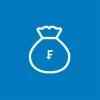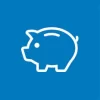There are many different products from Swiss banks which you can use to earn interest. These include savings accounts, private accounts, youth accounts, senior accounts, pillar 3a retirement accounts, vested benefits accounts, and medium-term notes. In this guide, moneyland.ch lists the different options, explains how much interest you can expect to earn, and tells you what you should pay attention to when using them.
Savings accounts
Savings accounts are the most popular instrument for earning interest in Switzerland. The interest rates of Swiss savings accounts experienced a long dry spell in recent years due to the negative interest politics employed by central banks. But even during the lowest points of the negative interest environment, there were still Swiss banks which stood out with relatively high interest rates.
The average interest rate across all Swiss savings accounts for adults is currently 0.29 percent. But the actual annual interest rates at individual banks range between 0 and 1 percent. Taking a moment to compare savings accounts is worth it. Some of the biggest Swiss banks are relatively stingy when it comes to interest paid on savings account balances.
Table 1: Savings accounts at the biggest Swiss banks
| Bank |
Highest possible interest rate |
| UBS |
0.3% |
| Raiffeisen |
0.3% |
| Zürcher Kantonalbank |
0.15% |
| Postfinance |
0.1% |
| Banque Cantonale Vaudoise |
0.15% |
| Migros Bank |
0.4% |
Although interest rates can change every month, the list of banks which pay the most interest on savings account balances often remains the same. So you do not need to change your bank every year in order to earn the highest possible interest. Additionally, teenagers and students get preferential interest rates (more on this under youth accounts further down).
Some savings accounts yield more interest than others. But in some cases, higher-yield accounts have special terms and conditions which must be met. For example, there may be tighter limits on withdrawals, or the high interest rate may only apply to new money added to the account, or if you buy shares in the bank or use its other banking products. For these reasons, it is important to review the exact terms and conditions when choosing a savings account.
It is also necessary to understand that the highest interest rates normally only apply to the portions of account balances which fall below certain limits. You earn little or no interest on the portion of your money which exceeds this threshold. The savings account comparison accounts for these limits for interest calculations.
Private accounts
Compared to savings accounts, private accounts are less suitable for holding savings because they pay less interest. But that does not stop the majority of Swiss from keeping part of their money in private accounts.
There is still currently almost no interest on Swiss private accounts. Only 9 of the accounts included in the moneyland.ch private account comparison pay any interest at all. The interest rates of these ranges between 0.01 and 0.25 percent per annum.
You can find the going interest rates in the private account comparison on moneyland.ch.
With private accounts too, the interest rates for youth and student accounts are normally much higher than those of standard accounts. Unlike most private accounts for adults, most of these special accounts yield interest (more on this under youth accounts further down).
Important: When choosing a private account, fees and charges are generally more important than interest. The private account comparison on moneyland.ch automatically shows you the total costs, minus interest earned.
Interest is not the only deciding factor
The annual interest rate is, in many cases, a good indicator of how good an offer really is. But when interest rates are generally low, then fees and charges play a more significant role. It is possible that a bank which offers the highest interest rate may not be the most favorable option. Because of this, the moneyland.ch comparisons account for all costs as well, so that you can find the best account for your specific needs.
Youth and student accounts
Many banks have exceptionally good interest rates for teenagers and students. These offers only apply up to a certain age, after which the account is migrated to a standard account at the same bank. The savings account comparison and private account comparison on moneyland.ch let you enter your age, and specify if you are a student. The results will then account for these youth and/or student offers.
For these offers too, savings accounts have higher interest rates than private accounts. Rates for youth and student savings accounts range between 0.25 and 1.25 percent interest per year. The average rate across all offers is 0.64 percent. Several large Swiss banks pay above-average interest for youth and student savings accounts (table 2).
Table 2: Youth saving accounts at the biggest Swiss banks
| Bank |
Highest possible interest rate |
| UBS |
0.6% |
| Raiffeisen |
0.7% |
| Zürcher Kantonalbank |
0.3% |
| Postfinance |
0.8% |
| Banque Cantonale Vaudoise |
0.65% |
| Migros Bank |
0.75% |
By comparison, the interest rates of private accounts for teenagers and students range between 0 and 1 percent per year. The average across all youth and student private accounts is 0.47 percent. The biggest Swiss banks are less generous with their private accounts, with the current highest rate being 0.5 percent (table 3).
Table 3: Youth private accounts at the biggest Swiss banks
| Bank |
Highest possible interest rate |
| UBS |
0.1% |
| Raiffeisen |
0.2% |
| Zürcher Kantonalbank |
0% |
| Postfinance |
0.25% |
| Migros Bank |
0.2% |
With youth and student accounts, the thresholds above which you no longer earn the higher interest rates are often very low. The typical youth private account balance threshold is around 35,000 francs, but some banks have limits as low as 5000 francs. The typical threshold for youth savings account balances is around 32,000 francs. So parents generally cannot earn huge amounts of interest by parking money in their children’s accounts.
Bank accounts for seniors
In addition to special accounts for young people, there are also special senior bank accounts for people above the age of 60. But from an interest perspective, using these is rarely more lucrative than using standard accounts.
The interest rates of senior savings accounts range between 0.15 and 0.35 percent. So the highest-yield senior account has a lower interest rate than the highest-yield standard savings account.
There are also a few private account offers which are exclusively for seniors. The interest rates of these offers are identical to those of regular private accounts, which currently means you earn practically no interest on private account balances.
Pillar 3a retirement accounts
As with regular savings accounts, it was the negative key interest rates imposed by central banks which kept the yields of pillar 3a retirement savings accounts low. You can find the current interest rates in the pillar 3a retirement account comparison on moneyland.ch.
Currently, the average interest rate of Swiss pillar 3a savings accounts is around 0.52 percent. That is slightly more than the average for standard savings accounts, rates range between 0.2 and 1.1 percent.
Table 4: Pillar 3a retirement accounts at the biggest Swiss banks
| Bank |
Highest possible interest rate |
| UBS |
0.6% |
| Raiffeisen |
0.6% |
| Zürcher Kantonalbank |
0.25% |
| Postfinance |
0.3% |
| Banque Cantonale Vaudoise |
0.35% |
| Migros Bank |
0.6% |
Some banks have slightly higher interest rates for their pillar 3a accounts than for their standard savings accounts. The disadvantage of pillar 3a accounts compared to regular savings accounts is that the money can only be withdrawn shortly before you reach retirement age.
Vested benefits accounts
Swiss savings accounts for vested benefits do not yield particularly high interest. Currently, the average annual interest rate is 0.22 percent. The interest rates of individual accounts range from 0 to 1 percent per year.
Table 5: Vested benefits accounts at the biggest Swiss banks
| Bank |
Highest possible interest rate |
| UBS |
0.2% |
| Raiffeisen |
0.3% |
| Zürcher Kantonalbank |
0.05% |
| Postfinance |
0.01% |
| Banque Cantonale Vaudoise |
0.05% |
| Migros Bank |
0.2% |
If you need an account for your vested benefits, you can find the most suitable offer using the vested benefits account comparison on moneyland.ch.
Medium-term notes
The rule governing the interest rates of medium-term notes is: The longer the bond term is, the higher the fixed interest rate will be. Medium-term note offers are updated regularly – every month, in some cases. So it is very important to compare current offers before buying medium-term notes.
The average interest rate across Swiss medium-term notes with one-to-two-year terms is currently around 0.42 percent per year. The average rate for notes with long 10-year terms is currently 0.74 percent. So, on average, medium-term notes with very long fixed terms have much higher interest rates than conventional savings accounts. The disadvantage: You can only cash out your medium-term notes to get your money back at the end of the predefined bond term.
It is also worth considering that the interest rate of a medium-term note remains the same across the full bond term. If you tie your money into a note with a very long bond term, and the interest rates offered by bank accounts and shorter-term fixed deposits go up in the meantime, you may miss opportunities to earn higher interest on that money.
Although medium-term note offers frequently change, the banks which pay the most interest generally remain the same.
Stock brokers and asset managers
Some online trading platforms not only offer custody accounts for securities, but also pay interest on the cash portion of your brokerage account. That means you earn interest for the money that sits in your account when it is not being invested. Stock brokers which pay interest on cash balances include Cornèrtrader, Saxo Bank, and Swissquote. Of the Swiss digital asset management services (robo advisors), Alpian pays interest on the cash portion of your account which is not invested.
Table 6: Interest paid by stock brokers and asset managers
| Service provider |
Annual interest rate |
| Alpian |
CHF: 0.275% for up to CHF 125,000, 0.6% or higher amounts.
This only applies to savings accounts, not to private accounts. |
| Cornèrtrader |
CHF: 0.6%
EUR: 0.75%
USD: 1% |
| Saxo Bank |
The interest rate depends on the size of your cash balance and on your account tier. |
| Swissquote Invest Easy * |
0.25% for up to CHF 50,000, 0.15% for up to CHF 100,000, for higher amounts 0.1%
1.25% for up to EUR 50,000, 0.75% for up to EUR 100,000, for higher amounts 0.3%
1.75% for up to USD 50,000, 1% for up to USD 100,000, for higher amounts 0.5% |
* The information relates to Swissquote Invest Easy. Customers of the Swissquote Trading product currently receive no interest.
Neobanks
Some neobanks also have interest rates which are comparable to those of conventional savings accounts. Neon no longer pays interest.
Table 7: Interest paid by neobanks
| Neobank |
Annual interest rate |
| Radicant |
0.25% for up to CHF 100'000, 0.5% from CHF 100'000 to CHF 250'000, 0.25% above that amount |
| Yuh |
CHF/EUR/USD: 0.25%
These rates only apply to money placed in saving area but not to the balance of the main account. |
| Zak |
0.1% for up to CHF 25,000, 0.75% on the Zak savings account up to CHF 100,000 |
More on this topic:
Swiss bank accounts with negative interest rates
Compare Swiss savings accounts now

 Deal of the Day
Deal of the Day 






